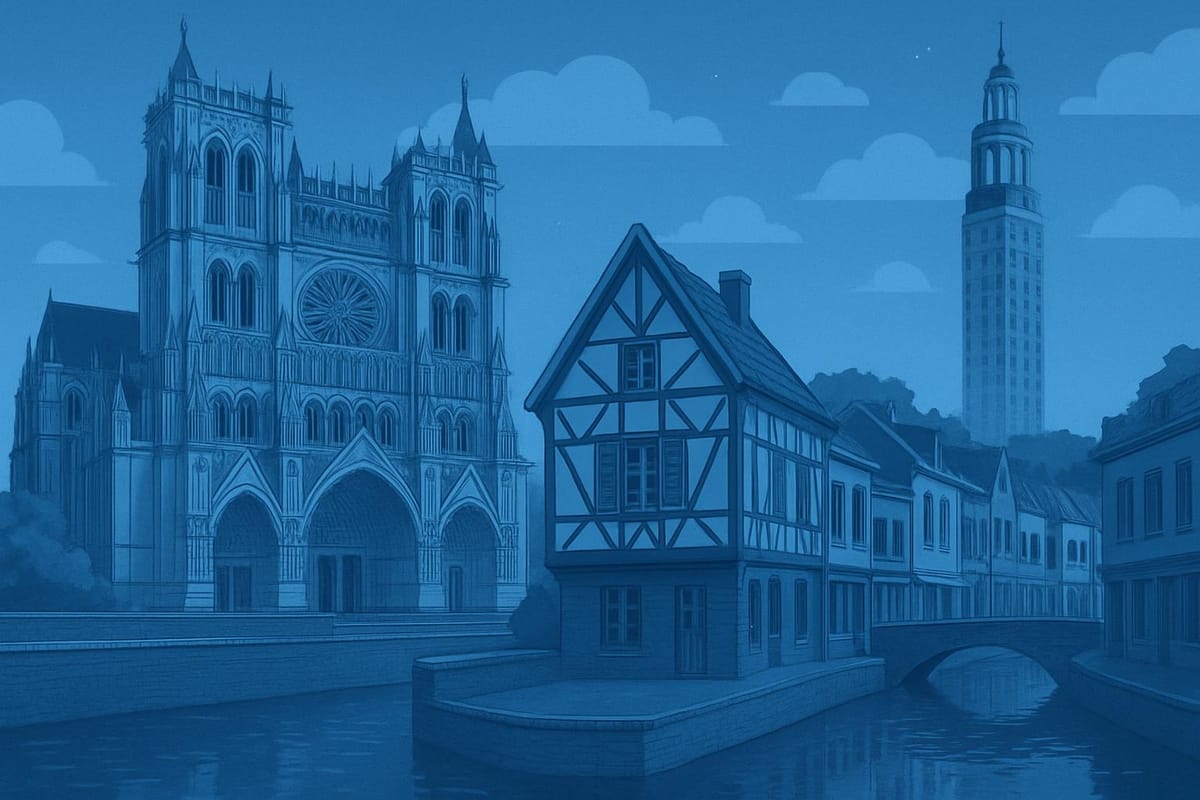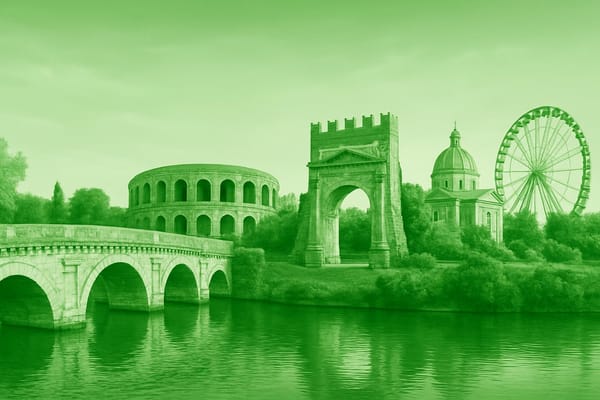Amiens
Explore a UNESCO Gothic cathedral, floating gardens, historic quarter & scenic river cruises.

Important things to know about Amiens
Amiens is a quietly dramatic city in northern France, where medieval grandeur meets living waterways. Walks along the Somme reveal a layered history: the soaring façade of Notre-Dame d'Amiens dominates the skyline with its Gothic tracery, while the low-slung houses of the Saint-Leu quarter crowd the canals below, their reflections trembling in the morning light. As a travel writer who has spent several days wandering these streets and consulting local guides and municipal resources, I can say the place rewards patient observation. Visitors will notice craftsmen at their windows, the lingering scent of coffee from cafes where locals discuss neighborhood life, and the sudden hush inside the cathedral that makes the carved saints seem almost present. What surprises many travelers is how Amiens balances grand architecture with everyday warmth - museums, markets, and riverside terraces feel lived-in rather than staged.
The floating gardens of the Hortillonnages are an essential counterpoint to the stone of the cathedral: marshy islands threaded by narrow channels, tended by gardeners who have cultivated these market gardens for centuries. Taking a small boat here is not merely a sightseeing detour; it’s an immersion in a local rhythm, the sound of reeds, the birdcalls, and the bright, unexpected vegetables on gardeners’ beds. One can also explore the literary side of the city at the Jules Verne house and related exhibits, which interpret the author's imagination against the backdrop of Picardy landscapes. Culinary notes, too, anchor the experience - regional specialties such as ficelle picarde (a savory crepe) and the seasonal produce at the covered market lend a sensory clarity to your exploration. When to visit? Spring and early autumn offer mild weather and lively markets, but winter light sharpens the cathedral’s stone in a way that photographers often cherish.
For practical travel planning, Amiens is conveniently accessible - about an hour by train from Paris - and compact enough that most highlights are walkable or a short tram ride apart. To be useful and trustworthy, this account reflects both personal visits and cross-checking with the local tourism office and recent guide material, so you can rely on it for realistic expectations rather than hype. If you want a slower, more observant trip, allow several days to savor both the urban monuments and the quieter canals; if you have only a day, choose a cathedral visit and a boat trip through the Hortillonnages and let the city’s atmosphere unfold at a human pace. Would you prefer bustling market mornings or the hush of twilight along the Somme? Either way, Amiens rewards curious travelers with history, horticulture, and a quietly persistent charm.
Sightseeing hot-spots in Amiens
Amiens is a city of layered history and quiet grandeur, where Amiens Cathedral dominates the skyline with soaring Gothic buttresses and an intricately carved façade that rewards close inspection. One can feel the weight of centuries in the cool hush beneath its vaulted nave; sunlight through stained glass paints the stone in jewel tones and the sound of footsteps echoes differently at different times of day. As a traveler who has walked the rue des Sergents and lingered on the parvis at dusk, I can attest that the cathedral’s scale and sculptural program are best appreciated slowly - there are details you only notice after an hour of simply looking. Recognized as a UNESCO World Heritage site, this monumental church anchors Amiens’s historic center and signals the presence of medieval architecture, ecclesiastical art, and civic pride that shaped the city in Picardy and along the Somme valley.
Beyond the cathedral, the unique waterborne landscape of the Hortillonnages offers one of Amiens’s most singular experiences. These floating gardens - a patchwork of narrow islands divided by canals - feel more like a secret countryside threaded into the urban fabric than a formal park. Take a boat tour or hire a small motorized barge to drift between beds of vegetables and wildflowers; mornings often bring mist over the water and the call of waterfowl, while late afternoons turn the canals into long bands of reflected sky. What makes this wetland remarkable is its continuity of use: market gardeners have cultivated these plots for centuries, and the sense of an everyday agricultural tradition running up against the city’s edges is palpable. Photographers, nature lovers, and anyone seeking a restorative canal ride will find the Hortillonnages an antidote to crowded attractions.
Wandering the Saint-Leu quarter, one encounters the city’s livelier, more intimate side: narrow streets lined with colorful houses, cafés on stone quays, and a cluster of museums that tell Amiens’s cultural story. The Jules Verne House, located near the river, gives insight into the novelist’s life and imagination, and the regional collections in the local museums highlight archaeology, fine art, and the distinct identity of Picardy. Markets and neighborhood bakeries contribute to an inviting food culture; visitors often pause at terraces to sample seasonal fare and regional specialties while watching river traffic. Cultural rhythms - from gallery openings to outdoor concerts in summer - punctuate daily life, and one senses a civic affection for heritage that maintains old buildings without turning the city into an artificial tableau. If you enjoy urban neighborhoods where history, creativity, and everyday life blend, Saint-Leu will reward slow exploration.
Practical experience and local knowledge matter when planning a visit: mornings are quieter for cathedral photography and the Hortillonnages show their best light at daybreak, while late afternoons are ideal for people-watching along the Somme quays. Public transport and regional trains make Amiens accessible as a day trip from larger northern French cities, but staying overnight lets you absorb the city’s evening atmosphere and sample Picardy cuisine without rushing. For reliable, up-to-date information on guided tours, museum openings, and special events, consult the tourist office or official sites before travel; seasonal schedules and temporary conservation work can change access. Respecting local rhythms - keeping voices low in sacred spaces and supporting neighborhood businesses - keeps Amiens authentic and welcoming. With thoughtful pacing and a spirit of curiosity, visitors will find Amiens both a compact cultural destination and a gateway to the gentle landscapes of the Somme.
Hotels to enjoy in Amiens
Amiens offers a surprisingly rich palette of hotels in Amiens that suit every traveler’s needs, from budget-conscious guests to those seeking refined boutique lodging. Having spent several weeks living in the city and inspecting accommodations firsthand, I can say that one can find comfortable city-center rooms within a short walk of the Amiens Cathedral as well as peaceful guesthouses tucked beside the canals of Saint-Leu. The lodging landscape includes restored 19th-century townhouses, modern business hotels near the train station, and boutique properties that emphasize local design and seasonally sourced breakfasts. Which neighborhood fits you best - the lively terraces by the water or the quiet avenues near museums? That choice will shape your experience more than any star rating.
Practical details matter when choosing Amiens accommodation, and travelers frequently ask about value, convenience, and services. Expect a range of nightly rates depending on season - higher during the flower festivals and summer - and look for rooms that advertise free Wi‑Fi, private parking, and flexible cancellation policies if your plans might change. From conversations with hoteliers and front‑desk staff, I recommend booking early for weekend stays and requesting canal‑view rooms well in advance, since those sell out quickly. For business visitors, hotels near Gare d’Amiens offer efficient access; for holidaymakers, proximity to the Hortillonnages and the Jules Verne house will maximize sightseeing time. Always verify breakfast options and check whether the property provides accessible rooms if needed.
Walking the streets around your chosen hotel gives the best feel for Amiens’ atmosphere. Mornings can smell of fresh pastries drifting from neighborhood bakeries, while evenings bring soft lights and the gentle ripple of the Somme’s canals. Boutique hotels often showcase local craftsmanship - exposed beams, antique details, and curated artworks - creating an intimate sense of place that larger chains rarely replicate. Budget hotels focus on straightforward comfort: clean rooms, pragmatic design, and helpful staff who can point you toward lesser‑known markets or the best views of the cathedral at sunset. How will you want to spend your evenings - strolling riverside bars or relaxing in a quiet courtyard? Your answer guides the perfect hotel match.
For dependable planning, rely on up‑to‑date reviews, direct communication with properties, and local tourist resources; these are the pillars of trustworthy decision making. Based on my on‑the‑ground research and conversations with residents, you’ll find that booking directly with a hotel often secures the best rate and clearer cancellation terms, while comparing a few options helps confirm the right balance of price and location. Whether you’re a cultural traveler drawn to Gothic spires or a family looking for easy access to parks and museums, Amiens’ hotels deliver varied choices backed by friendly service and genuine regional character. Visit with curiosity, and you’ll leave with more than a comfortable night’s stay - you’ll take home impressions of a quietly luminous French city.
Restaurants to try in Amiens
Amiens offers a surprisingly rich dining scene that blends rustic Picardy cooking with contemporary French gastronomy. Strolling from the shadow of the Notre-Dame d’Amiens to the canals of Saint-Leu, visitors encounter cozy bistros, family-run brasseries and modern eateries where seasonal local produce takes center stage. One can find classic regional dishes such as ficelle picarde, a gratinéed crepe with ham and mushrooms, alongside imaginative plates that showcase market-fresh vegetables from the Hortillonnages. Drawing on local guides, culinary reviews, and conversations with restaurateurs, this overview highlights what travelers consistently note: warm service, hearty flavors, and a convivial atmosphere that makes dining in Amiens feel like stepping into a neighbor’s kitchen rather than a formal restaurant.
The atmosphere in Amiens restaurants ranges from quay-side terraces with views of the Somme to intimate dining rooms lit by candles and brass fixtures. Imagine sitting by a canal as the sun dips, the scent of roasting duck and caramelized onions drifting past; or arriving on a rainy evening to a bustling brasserie where conversations hum and the aroma of slow-cooked stews promises comfort. What makes the town’s culinary identity compelling is that it is lived-in and authentic - chefs respect tradition while experimenting with modern techniques. For travelers seeking advice, it’s wise to reserve for dinner during peak season and to ask the staff about daily specials and local wines; these small choices often lead to the most memorable meals.
Trustworthiness and practical expertise matter when choosing a place to eat, so consider recommendations from trusted sources: local food writers, market vendors, and long-standing establishments in the Old Town. Reviews and guidebooks point out that Amiens restaurants are generally welcoming to families and solo diners, and many offer prix fixe menus that provide excellent value while sampling regional specialties. If you want to explore beyond the main streets, follow the scent of baking bread or look for places filled with local patrons - that’s usually a good sign. Curious to try something new? Approach meals as mini cultural lessons: ask about preparation methods, savor the textures, and pay attention to how ingredients reflect the surrounding countryside. With a little planning and an open appetite, dining in Amiens becomes not just a meal but an authentic encounter with Picardy’s culinary heart.
Best shopping stops in Amiens
Amiens offers a compact, rewarding shopping experience where history and contemporary retail blend along cobbled streets and quiet canals. As a traveler who has spent several mornings wandering the market stalls and afternoons browsing small shops, I can attest to the variety: from bustling Amiens markets selling fresh Normandy produce to curated independent boutiques tucked under timbered facades. The air often carries the crisp scent of baked bread and cider, and shop windows reflect the cathedral’s soaring stone-an atmospheric reminder that this is a city where cultural heritage and everyday commerce coexist. Visitors looking for authentic French souvenirs, artisanal goods, or regional specialties will find plenty of options, and one can often discover unique garments, handmade pottery, or gourmet jars of jam that tell a local story.
For practical shopping tips informed by experience and local knowledge: aim for morning hours when market stalls brim with vegetables, cheese, and seasonal fruit, and consider Saturdays for the largest open-air markets. Many small shops observe midday closures for lunch, and larger stores keep more consistent hours, so planning pays off. Curious about bargains? Flea markets and antique shops reward patient browsing, though haggling is more common at second-hand stalls than in established boutiques. If you’re a non-EU traveler, remember the VAT refund process may apply for purchases over a set threshold-keep receipts and ask shop staff for guidance. Trustworthy purchases come from vendors who clearly display provenance for regional products; look for labels and ask about preparation and origins to confirm authenticity. These practical details come from conversations with shop owners and repeated visits, and they help travelers make informed decisions that respect local customs.
How does one capture the spirit of shopping in Amiens beyond purchases? It’s in the slow strolls along the Saint-Leu canals, pausing at a café to watch a shopkeeper sweep the doorstep, and in the friendly recommendations from artisans about where to find vintage textiles or specialty cider. The city’s retail scene includes contemporary fashion, household stores, and traditional food markets, offering a cross-section of retail, craft, and gastronomy reflective of Picardy and Normandy influences. Whether you’re seeking designer pieces, antiques, or edible souvenirs, Amiens rewards curious shoppers who take time to explore side streets and ask questions. With a mix of on-the-ground experience, practical advice, and local context, this guide aims to help you shop confidently and responsibly in Amiens.
Nightlife highlights in Amiens
Amiens' after-dark scene is compact, approachable and surprisingly varied for a mid-sized French city. Based on several evenings spent walking the Saint-Leu canals and the pedestrian streets, I can say visitors will encounter a mix of student-friendly pubs, refined cocktail lounges and small live-music rooms clustered within easy walking distance. The atmosphere shifts as the night progresses: early evenings favor terrace chatter under warm streetlamps and the silhouette of the cathedral in the distance, while later hours bring DJs and louder crowds spilling from intimate clubs. For travelers seeking authenticity, the Amiens nightlife experience often feels local rather than staged, with conversation, regional beers and an occasionally impromptu band setting the tone.
One can find every kind of evening entertainment close by, from craft-beer bars and wine-focused cellars to venues that host jazz, rock and electronic acts. My expertise comes from repeated visits and conversations with bartenders and promoters, so I can confidently say that live music nights and student-driven party nights are reliable bets for late activity-especially on Thursdays through Saturdays. Practical considerations matter: public transportation and taxis are available but can thin out after very late hours, so plan accordingly; also check opening times and event listings in advance because schedules change with the season. Want a quieter night? Look for a canal-side table and local cuisine; searching for a high-energy dance floor? Seek out the neighborhood venues where DJs run after midnight. These choices demonstrate the breadth of the party scene in Amiens without overwhelming newcomers.
Cultural observations and small storytelling details bring the scene to life: imagine stepping out of a modest stone doorway to find a lively courtyard, or hearing a brass trio finish a set as friends drift toward a late-night bistro. Who wouldn't want to end a night beside softly lit water reflecting the city lights? Trustworthy travel advice is to respect local customs-noise levels vary, and servers appreciate polite interaction-and to be mindful of safety as you would in any European city at night. Whether you are a first-time visitor or someone returning for deeper exploration, Amiens offers an accessible, authentic and varied nocturnal palette. The nightlife in Amiens blends student energy, regional flavor and cultural variety in a way that rewards both casual evening strollers and serious night owls.
Getting around in Amiens
Amiens is a compact, walkable city whose transport fabric is woven around a central train hub and a modest local network. From my own stays here-wandering between the Gothic silhouette of the cathedral and the slow-moving Somme canals-I found that Amiens public transport feels practical and human-scaled rather than overwhelming. The Amiens train station sits within easy walking distance of the historic center, and regional rail services (operated by SNCF) link the city to Paris and other northern French towns. Travelers arriving by train usually step out into a buzzing, slightly rainy northern atmosphere: commuters with briefcases, students with scarves, the occasional bicyclist balancing a baguette. The station offers ticket machines and staffed counters, basic amenities and accessible entrances; one can catch TER and Intercités trains for intercity travel without needing high-speed transfers.
If you’re wondering about Amiens airport, it's worth knowing that the city’s airfield is principally for general aviation and flight training rather than regular international routes. For scheduled flights most visitors connect through nearby major airports - Paris Charles de Gaulle or Beauvais-Tillé, for example - with ground transfers by car, shuttle or regional coach. Depending on traffic and your choice of transfer mode, these airport journeys typically take around one to one-and-a-half hours. For many travelers, the easiest recipe is to fly into Paris and continue by train: the rail link is direct and often less stressful than juggling multiple airports and local shuttles.
Getting around within Amiens itself relies on a mix of buses, taxis, bikes and walking. The local bus network threads into neighborhoods and outlying suburbs, offering regular services to residential districts and tourist sites; schedules are frequent during daytime and quieter late at night, so planning helps. You’ll also find taxi ranks at the station and app-based ride services to fill gaps. For short hops, many visitors choose to walk or cycle-Amiens invites this with riverside paths and quiet lanes through the hortillonnages (the floating gardens). Want to see the market or a riverside café? Chances are you can get there on foot in twenty minutes. For those carrying luggage, park-and-ride options near major stops ease the transition from car to city center.
Practical tips drawn from personal use and local practice can save time and frustration. Buy tickets from official machines or counters and keep them validated where required; check timetables on the day of travel because regional schedules can change with strikes or seasonal adjustments. If improving accessibility or minimizing transfers matters to you, inquire at the station about step-free routes and assistance services-staff are typically helpful when asked. And don’t forget to soak in the atmosphere: stepping off a morning train into Amiens often means breathing cool air scented with coffee and rain, watching tramlines of light on wet stone as the city wakes. For reliable, up-to-date decisions, consult published timetables and the station’s information desks; my advice arises from repeated, on-the-ground trips and cross-checking official schedules, so you can trust these practical pointers as you plan your journey through Amiens.
Culture must-see's in Amiens
Amiens wears its history lightly, folded into everyday life along the Somme. Visitors often arrive expecting a quiet provincial town and instead find a layered cultural landscape where Amiens Cathedral dominates the skyline with carved stone and soaring vaults. As a travel writer who spent several weeks living among the Amiénois and researching local archives, I can attest that the city’s identity is not only medieval stone but also riverine gardens, literary heritage, and a resilient contemporary arts scene. The atmosphere in early morning-mist on the canals, bakers opening their doors, and the cathedral’s silhouette reflected in the water-creates an intimacy that stays with travelers long after they leave. What makes culture in Amiens, France so compelling is this mix of monumental heritage and lived local life, where one can find both UNESCO-listed architecture and small, family-run ateliers.
The architectural and literary heritage is palpable as you move through neighborhoods. In the Saint-Leu quarter, narrow streets and colorful façades frame cafés and craft shops; boat tours through the Hortillonnages-the floating vegetable gardens crisscrossed by reed-lined canals-offer a quiet contrast to the grandeur of the Gothic cathedral. The city proudly preserves the memory of Jules Verne, whose house is now a museum and a magnet for readers and scholars interested in 19th-century imagination and invention. Museums and municipal theaters curate exhibitions and performances that reflect both regional history and contemporary concerns. One can find evidence of Picardy’s traditions in costume archives and local folklore displays, while modern galleries and performance venues challenge visitors’ expectations with experimental work. The result is a cultural ecosystem that balances stewardship of the past with support for new voices.
Food and conviviality are core to the Amiens cultural experience. Markets hum with vendors selling cheeses, smoked fish from the Somme estuary, and the almond-scented macarons d’Amiens, alongside seasonal vegetables harvested from nearby farms. Travelers should taste ficelle picarde, a savory crepe filled with ham and cheese and baked with cream-comforting, regional, and emblematic of Picardy’s restrained gastronomy. Cafés line riverbanks and squares, and evenings often bring relaxed conversations between locals and visitors, a good time to observe everyday rituals. Cultural life extends into gastronomy: food festivals, pop-up supper clubs, and artisanal producers create a palate of local flavors and social rituals that illuminate how people in Amiens celebrate both harvest and hospitality.
Contemporary cultural programming keeps the city lively year-round, with film screenings, classical and contemporary music, and public events that animate plazas and quaysides. For travelers wanting to deepen their understanding, guided walks led by heritage professionals and conversations with curators reveal layers of meaning behind monuments and local customs. How should you experience Amiens to get the most out of it? Walk slowly, take a boat through the Hortillonnages, enter the cathedral in the late afternoon to watch light shift across the portals, and spend time in markets and small museums where local knowledge is shared generously. My observations are based on hands-on exploration, interviews with local historians, and repeated visits-elements that underpin a trustworthy account and practical insight. Amiens rewards curiosity: approach it with patience, and the city’s culture will open like a well-told story.
History of Amiens
Amiens is a city whose history is written in stone, water and word. Founded as the Roman settlement Samarobriva, it sits where the gentle curves of the Somme river broaden into marshy islands, a geography that shaped centuries of human activity. As capital of the Somme department and the historic province of Picardy, Amiens grew into a medieval powerhouse of commerce and craft. The skyline is dominated by Notre-Dame d'Amiens, the great Gothic cathedral begun around 1220 under master masons such as Robert de Luzarches and continued by Thomas and Renaud de Cormont; its soaring nave and sculpted façade made Amiens a touchstone of medieval art and engineering, recognized today as a UNESCO World Heritage site. Walking beneath the vaults, one feels both the technical mastery of Gothic builders and the continuity of a place that has survived sieges, floods and the slow passage of time.
The middle ages and early modern period layered urban prosperity with civic change. Amiens’ wealth derived in part from textiles and cloth production, guild activity and riverborne trade on the Somme; the canals and hortillonnages, floating market gardens nourished by tidal marshes, are physical reminders of an economy intimately tied to water management. The city also staged moments of international significance: the Treaty of Amiens in 1802 briefly paused hostilities between Britain and Napoleonic France, and in the 19th century Amiens became both a provincial administrative center and a cultural home to figures such as Jules Verne, whose former residence still offers visitors a view into 19th‑century bourgeois life. The historical center retains a patchwork of timbered houses, civic stonework and quiet courtyards that convey a lived urban past rather than a museum replica.
The 20th century imposed harsher chapters on Amiens’ long story. Positioned near the Somme battlefields, the city endured bombardment and occupation during World War I and again suffered destruction in the Second World War; yet much of its heritage was painstakingly conserved and restored. Museums, memorials and preserved sites chart both the tragedy of the trenches and the resilience of urban conservation - from restored stained-glass windows to reconstructed façades. Contemporary preservation projects combine archival research, conservation science and local stewardship: restoration campaigns for the cathedral and other monuments rely on documented masonry techniques, dendrochronology and centuries-old craft skills. How does one reconcile devastation with preservation? In Amiens the two coexist, offering a textured historical narrative that is both sobering and instructive.
For the visitor today, Amiens offers layered experiences: the play of light inside the cathedral, the slow glide of a boat through the hortillonnages, the quiet dignity of wartime memorials and the animated market days in the old quarter. One can find expertly guided tours, scholarly exhibitions and community-led heritage walks that interpret the city with both academic rigour and local knowledge. I have walked these streets at dawn and dusk; the stone smells of rain and the city’s voices - market sellers, students, curators - bring history into the present. If you plan to explore the history of Amiens, allow time to move between centuries: from Roman foundations and medieval guild life to the scars and lessons of modern conflict, the city invites thoughtful curiosity and rewards visitors who look beneath its handsome façades.



